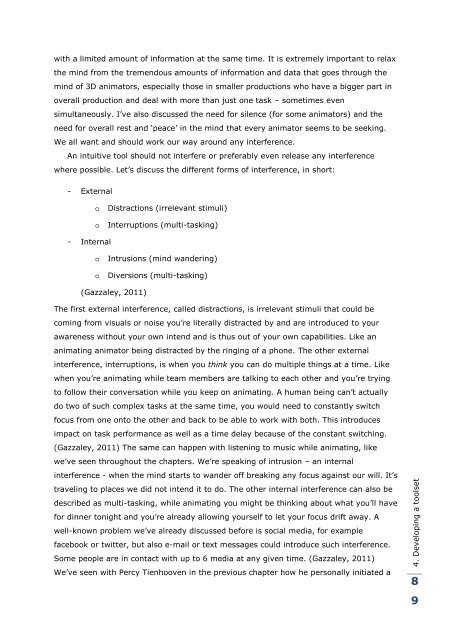Release. Pressure. Animate.
Release. Pressure. Animate.
Release. Pressure. Animate.
You also want an ePaper? Increase the reach of your titles
YUMPU automatically turns print PDFs into web optimized ePapers that Google loves.
with a limited amount of information at the same time. It is extremely important to relax<br />
the mind from the tremendous amounts of information and data that goes through the<br />
mind of 3D animators, especially those in smaller productions who have a bigger part in<br />
overall production and deal with more than just one task – sometimes even<br />
simultaneously. I‟ve also discussed the need for silence (for some animators) and the<br />
need for overall rest and „peace‟ in the mind that every animator seems to be seeking.<br />
We all want and should work our way around any interference.<br />
An intuitive tool should not interfere or preferably even release any interference<br />
where possible. Let‟s discuss the different forms of interference, in short:<br />
- External<br />
- Internal<br />
o Distractions (irrelevant stimuli)<br />
o Interruptions (multi-tasking)<br />
o Intrusions (mind wandering)<br />
o Diversions (multi-tasking)<br />
(Gazzaley, 2011)<br />
The first external interference, called distractions, is irrelevant stimuli that could be<br />
coming from visuals or noise you‟re literally distracted by and are introduced to your<br />
awareness without your own intend and is thus out of your own capabilities. Like an<br />
animating animator being distracted by the ringing of a phone. The other external<br />
interference, interruptions, is when you think you can do multiple things at a time. Like<br />
when you‟re animating while team members are talking to each other and you‟re trying<br />
to follow their conversation while you keep on animating. A human being can‟t actually<br />
do two of such complex tasks at the same time, you would need to constantly switch<br />
focus from one onto the other and back to be able to work with both. This introduces<br />
impact on task performance as well as a time delay because of the constant switching.<br />
(Gazzaley, 2011) The same can happen with listening to music while animating, like<br />
we‟ve seen throughout the chapters. We‟re speaking of intrusion – an internal<br />
interference - when the mind starts to wander off breaking any focus against our will. It‟s<br />
traveling to places we did not intend it to do. The other internal interference can also be<br />
described as multi-tasking, while animating you might be thinking about what you‟ll have<br />
for dinner tonight and you‟re already allowing yourself to let your focus drift away. A<br />
well-known problem we‟ve already discussed before is social media, for example<br />
facebook or twitter, but also e-mail or text messages could introduce such interference.<br />
Some people are in contact with up to 6 media at any given time. (Gazzaley, 2011)<br />
We‟ve seen with Percy Tienhooven in the previous chapter how he personally initiated a<br />
4. Developing a toolset<br />
8<br />
9


